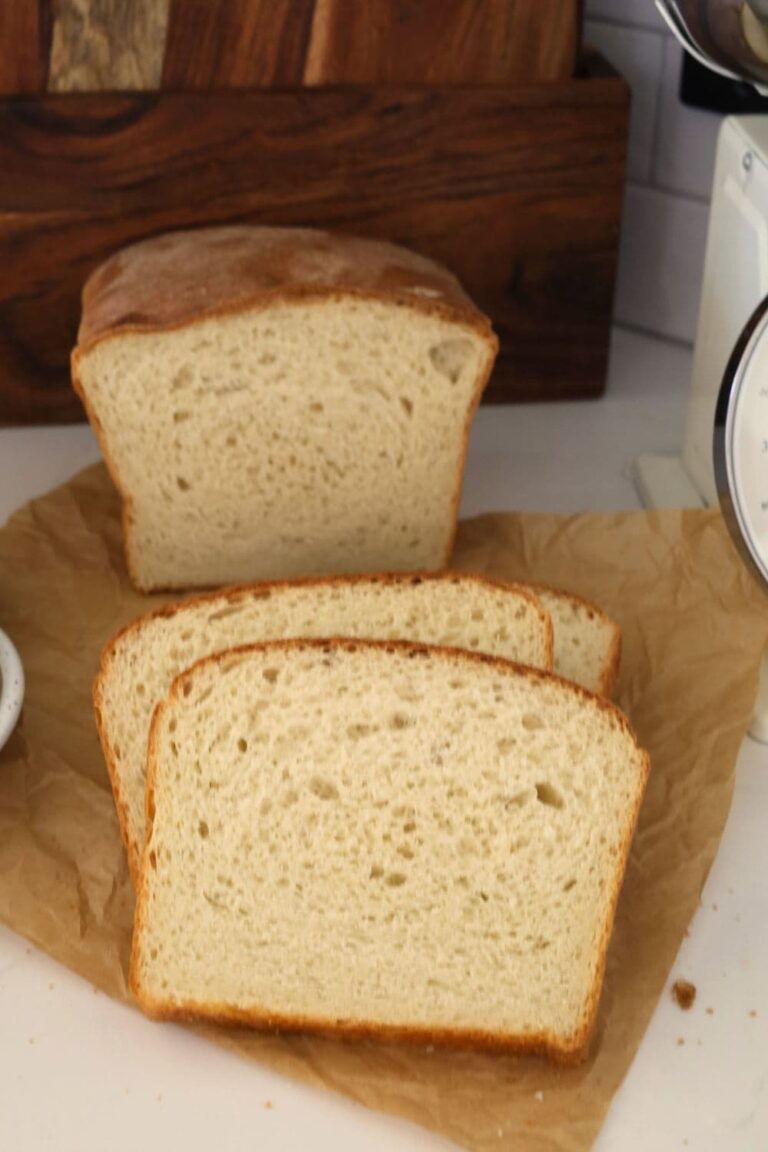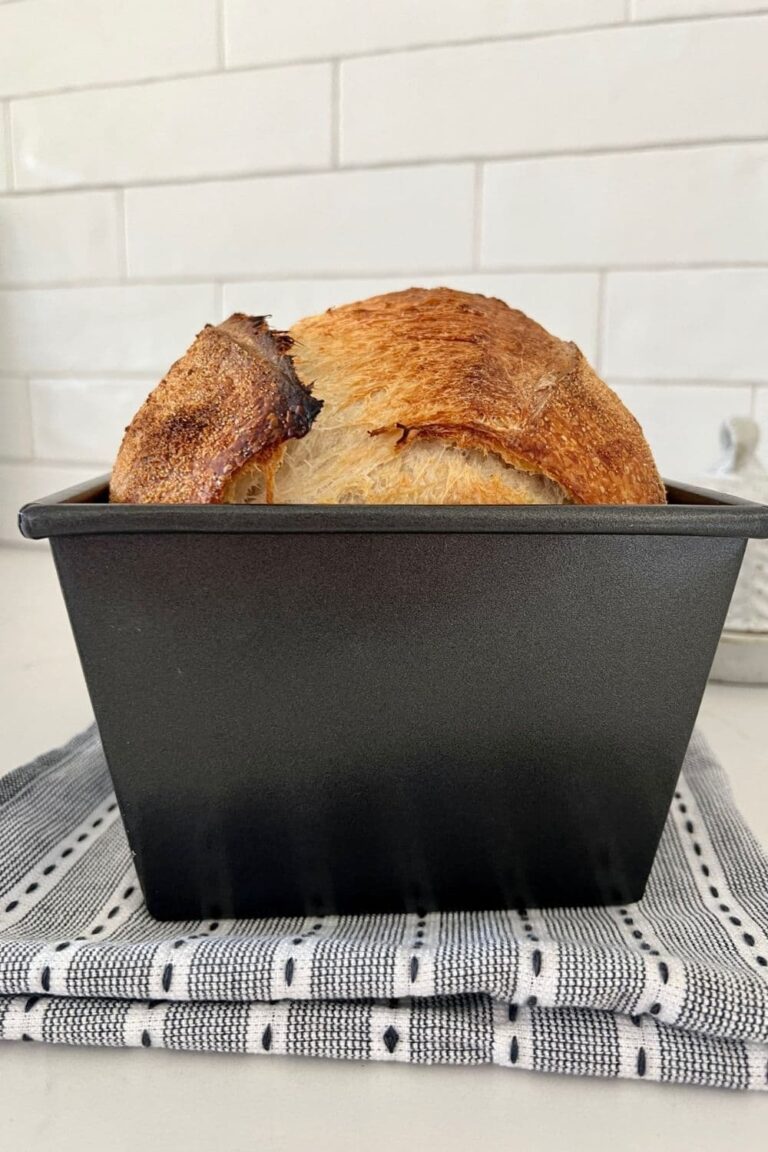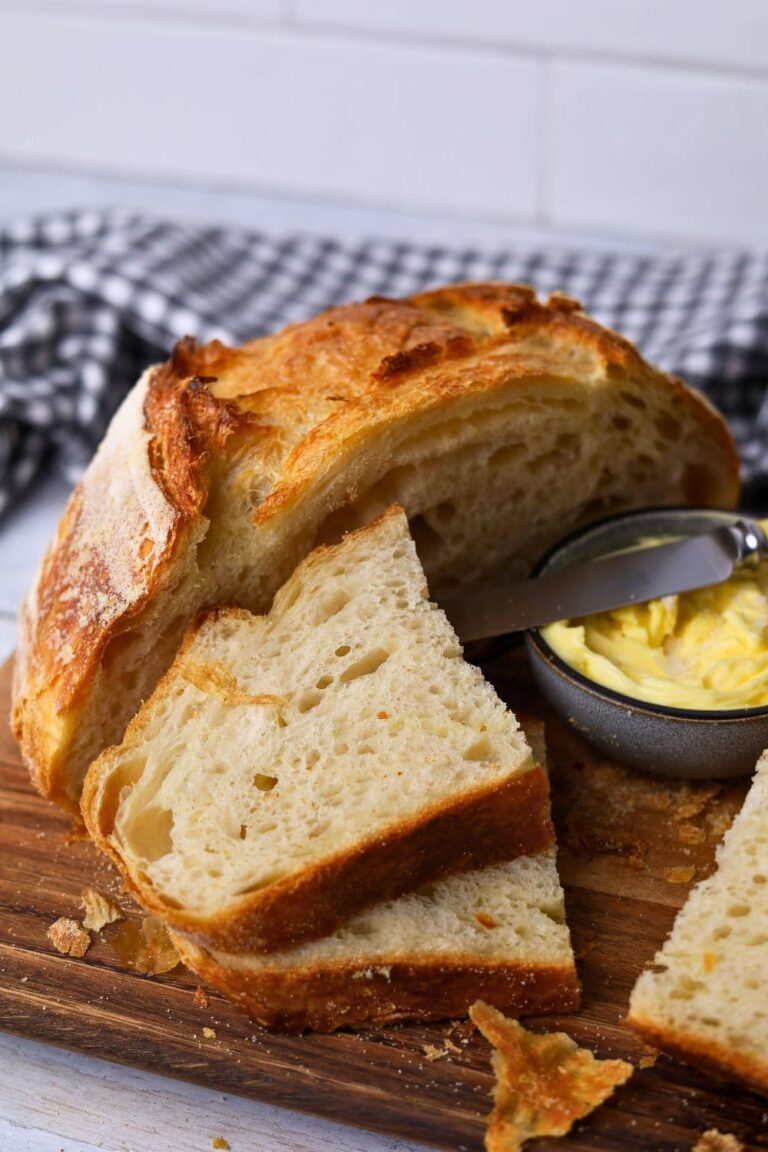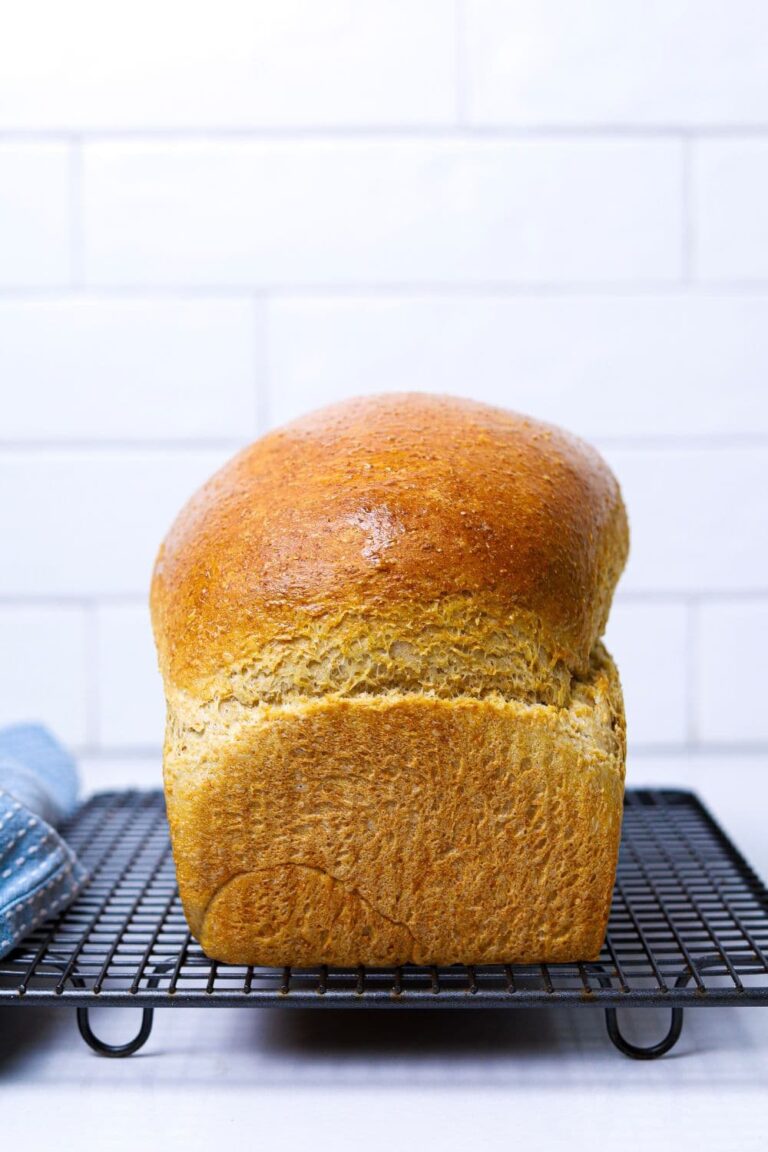Sourdough Parmesan Bread with Rosemary: Fragrant & Delicious!
This post may contain affiliate links.
Sourdough parmesan bread with rosemary is a fragrant sourdough bread that can be used for many ocassions.
Sourdough parmesan bread can be flavored with many different types of herbs, the most popular being rosemary.
This delicious flavor combination can be shaped into a batard, boule or even a couronne like in this photo.
Serve this cheese sourdough next to a bowl of soup, spaghetti bolognese or even as the centrepiece on your next charcuterie platter.
And if you love fragrant sourdough bread, why not try this roasted garlic sourdough bread with fresh rosemary?

Making Sourdough Bread
Making sourdough bread is a more in depth process than making yeasted bread. You will require an active and bubbly sourdough starter.
If you don't have one, you can learn how to establish one here.
It's best to make this bread when your starter is at its peak and the yeast colonies in the starter are the most active.
This bread develops the best flavor when it's allowed to cold ferment for at least 12 hours.
The fermentation process will ensure you have a well developed sourdough flavor, which works really well with the parmesan cheese.
How To Make Sourdough Parmesan Bread
Making this sourdough parmesan bread is quite simple. The flavors are added during the stretch and fold phase.
You can substitute the rosemary for any herbs you have on hand - but I find that rosemary is the most fragrant and works particularly well with parmesan cheese.
I have used a few sprigs of fresh rosemary. The fresh leaves have been stripped off the stalk and just added broke them up a little before adding them.
I haven't chopped them at all.
Here is the basic process for making sourdough parmesan bread:
- Autolyse the sourdough starter, water, flour and salt.
- Form up the dough and then let it rest.
- Develop gluten through stretches and folds and add parmesan and rosemary.
- Bulk ferment the dough.
- Shape the dough and place inside the banneton.
- Cold ferment the dough.
- Score and bake!
You can learn more about the full sourdough process here.
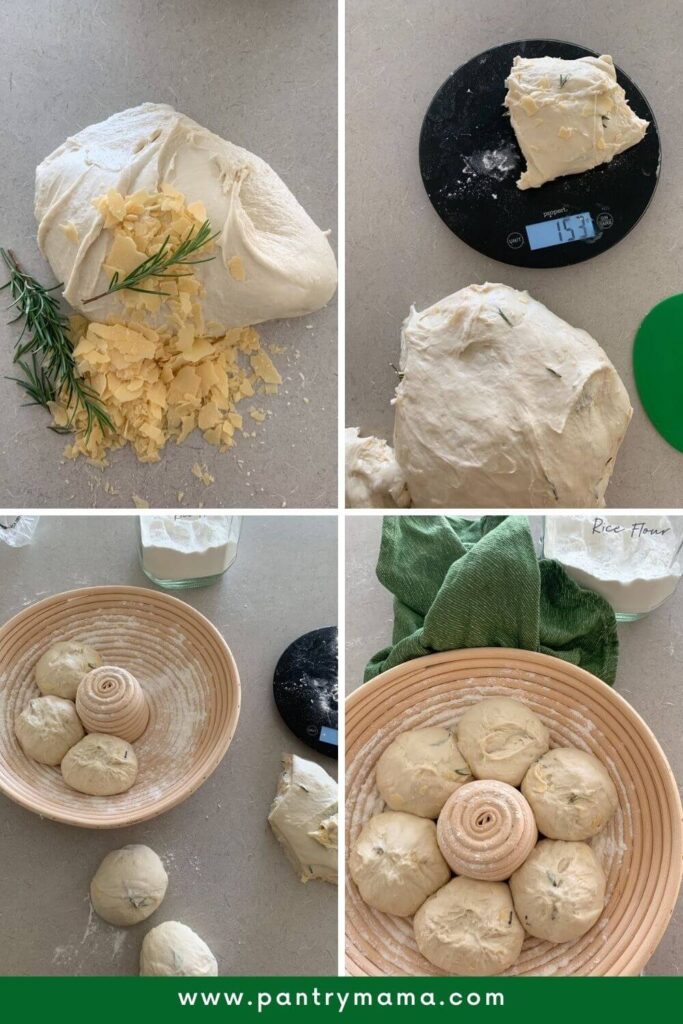
Shaping Sourdough Parmesan Bread
For this recipe, I have chose to shape sourdough parmesan bread into a wreath using a couronne, but this bread works as a batard or boule too.
I had this couronne sitting on top of my cupboard and really wanted to try it out - so on a whim I shaped this parmesan and rosemary bread into a wreath.
It was so lovely and is definitely a shape I want to explore more!
To create the wreath, I divided the fermented dough into 6 equal rounds of 150g each. I placed them into the couronne banneton touching each other and let them cold ferment like this for 24 hours.
The small balls of sourdough have been shaped like a boule (so all the edges brought into the centre and then turned over to tighten). You can see a video here.
This banneton is a couronne - basically a banneton with a mound on the middle which allows you to create a wreath shaped bread. This banneton is 11" in diametre and I used approx. 900g of dough.
For other types of bannetons or to ensure you correct the right size for your dough weight, check out this banneton size guide.

Flavor Variations
While parmesan and rosemary work in harmony in this delicious sourdough bread, you could use some substitutes, or even add some extras to make this bread super special.
- Instead of rosemary, you could use fresh parsley or thyme.
- For added flavor, brush this sourdough with garlic butter when it is removed from the oven.
- You can use dried herbs for this bread, but no more than 2 tablespoons of dried herbs or you will overpower the flavor.
- For something different fill the centre of the wreath with a selection of cheese and olives or your favorite dip!
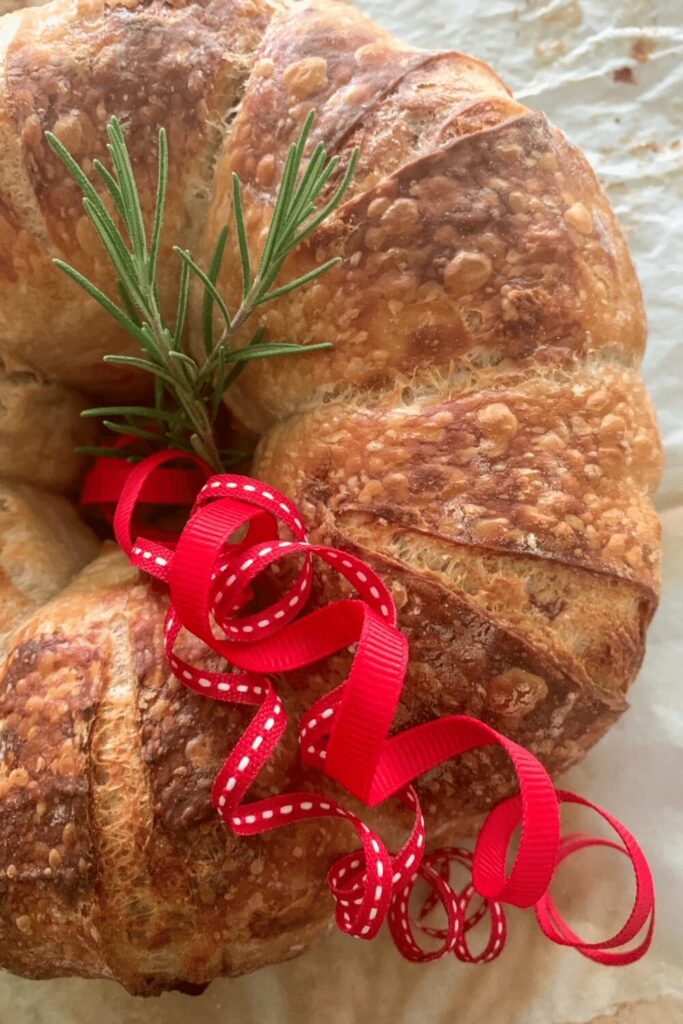
Further Reading
If you enjoyed this recipe, you might like to try these ideas:
- Sourdough Olive Bread
- Parmesan & Rosemary Sourdough Crackers
- Whipped Herb Butter (it tastes amazing spread on this cheesey sourdough).
- Jalapeño Cheese Sourdough Bread
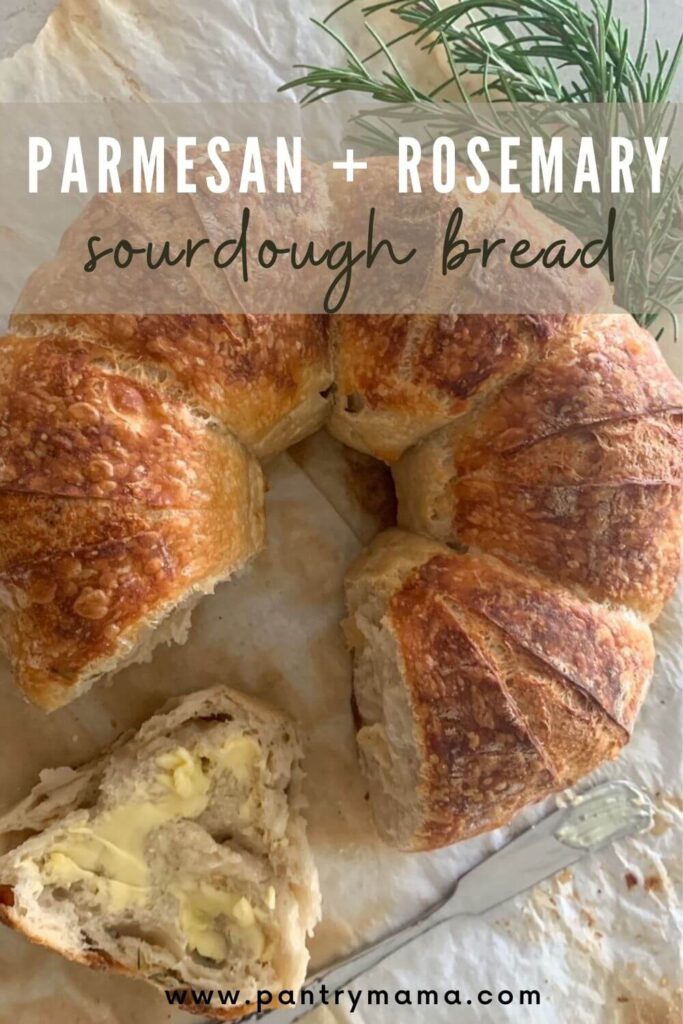

Sourdough Parmesan Bread with Rosemary
Equipment
- Mixing Bowl
- Digital Scales
- Banneton
- Dutch Oven
Ingredients
- 500 g Bread Flour
- 350 g Water
- 50 g Sourdough Starter (Fed and Bubbly)
- 150 g Parmesan Cheese Shaved or Shredded
- 10 g Salt (increase or decrease according to your taste)
- 1 sprig Rosemary fresh leaves
Instructions
- Autolyse - Premixing The DoughWeigh out your sourdough starter and water into a large ceramic or glass bowl. Glass is always good as you can see what's happening underneath your dough. This recipe is based on you having an active starter that you have fed a few hours before starting your bake.Mix the water and starter together briefly. Then add your flour and salt and mix whole lot together to form a shaggy dough. I find a dough scraper the easiest way to mix it as you can keep the sides of bowl clean.The dough will be fairly shaggy and only just brought together (see photo). You might wonder how this will turn into bread, but just wait, time is your friend and the dough will change in around an hour.
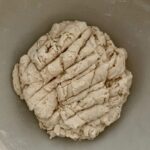
- Cover your bowl with cling film or a damp tea towel and let it sit for around 1 hour. It's ok if it's a little bit longer, it's not going to matter too much.This process is called the "autolyse" and allows your flour to soak in all the water and become hydrated. You can see how the dough has changed in this photo.
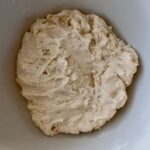
- Forming Up The DoughAfter the dough has been through autolyse you need to bring it together into a ball. Work your way around the bowl, grabbing the dough from the outside, stretching it up and over itself, into the centre, until a smooth ball is formed. You shouldn't need more than about 20-25 stretches to form the ball.You'll notice that the dough is fully hydrated after soaking all the water up. It will be fairly sticky but as you bring it into a ball, it will become smoother and shinier.

- Once the dough has formed into a smooth ball, pop the cling film back on and let it rest for 30 minutes.
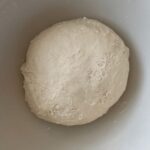
- Stretch & Fold + Adding Parmesan & RosemaryOver the next few hours you need to create some structure for your dough by "stretching and folding", as well as incorporating the rosemary and parmesan.Aim to do around 4-6 sets of stretches and folds. For each set, stretch the dough up and over itself 4 times. Leave around 15 minutes in between each set. Again you do not have to be exact with time, but you need to do at least 4 sets over 2 hours.You'll need to add the parmesan and rosemary around the second set of stretch and folds.
- Bulk FermentOnce you've finished your stretch and folds, place the cling film or damp tea towel back over your dough and let it rest and ferment. See notes below for more info on this step.
- Shaping The DoughOnce your dough has finished it's first ferment, it's time to shape it into either a boule or a batard (or couronne if you have one).
- Placing Into A BannetonOnce the dough is shaped into a tight ball, place it into your banneton smooth side down, so your seam is on the top - this way the top of your dough will get the pretty lines from the banneton. If you're using a cloth or tea towel in a bowl it's ok to put your dough with the smooth side up. Just make sure the dough is tight.Lift your dough around the edges to pop a little more rice flour if you feel it needs it. Just try to handle the dough as little as possible and be really gentle as you really want to preserve all the gases and air bubbles that have formed during your bulk ferment.
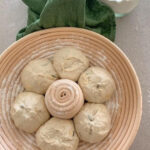
- Cold FermentNow the dough is in its "shaping container" cover it loosely with a plastic bag or damp tea towel and place into the fridge. I use a large plastic bag to cover it - I just reuse it each time. Try to leave it in the fridge for a minimum 5 hours up to a maximum of around 36 hours. The longer you leave it the better your bread will be! A longer cold ferment creates beautiful blisters on your crust and a deeper sourdough flavour. It will also ensure your dough forms a skin which makes it easier to score.
- Preparing To BakeOnce you're ready to bake your sourdough, you'll need to preheat your oven to 230C/450F. Place your Dutch Oven into the oven when you turn it on so it gets hot. Try to preheat for around 1 hour to ensure your oven is super hot - but you know your oven so just adjust this time if you need to.Leave your dough in the fridge until the very last minute - placing a cold dough into a hot oven will give you a great "spring".
- Bake Time!Now it's time to bake!When your oven is at temperature, take your sourdough out of the fridge. Gently place it onto a piece of baking paper. Make sure that you make the baking paper big enough to use the edges as a handle to lower to dough into your Dutch Oven.Gently score your bread with a lame, clean razor blade or knife. At minimum a large cross is sufficient, but you can get as artistic as you like. Try to score it fairly deep to ensure the dough opens up.Carefully take your dutch oven out of the oven. Place the sourdough into the pot using the baking paper as a handle. Put the lid on and place into the hot oven. If you want to you can spritz your dough with extra water before you put the lid on.BAKE TIME:30 Minutes with the lid on at 230C/450F plus10-15 Minutes with the lid off at 210C/410F
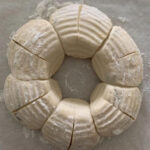
- Finishing The BakeWhen you remove your dough from the oven, carefully remove it from the dutch oven as soon as possible and place on a wire rack to cool.
Notes
- Notes on Flour: This recipe is written using strong Bread Flour. Bread flour has a higher protein content than All Purpose flour. If you choose to use All Purpose flour you may have a different result because of this.
- Notes on Sourdough Starter: This recipe is based on you having an active starter that you have fed a few hours before starting your bake. For information on whether your starter is ready, go here.
- Notes on Stretch & Folds: If you are going to do the stretch & folds on your bench top, spray your surface with water mist rather than using flour. You can leave the dough in the bowl if you want to. Wet your hands to stop the dough sticking - although it shouldn't be too sticky. It will get less sticky as you do your stretches and folds.
- Notes on Bulk Fermentation: If your home is warm then your dough will ferment a lot faster and could be done in as little as a few hours. If it's colder, it will take longer, possibly overnight.
I would recommend that you try to do your first few bulk ferments during daylight hours so that you can watch your dough closely.
Once you're more familiar with the process - and the temperature of your home - you will be able to do overnight ferments. You will know your dough is ready to move to the next stage when it has *just* doubled in size. It will be fairly wobbly and full of bubbles. You should be able to see large air bubbles under the surface of the dough.
You don't want to let it go any further than doubled as it will be over fermented.
If you want to do an overnight ferment, but your home is warm, consider using a little less starter (ie 25g).
Less starter means your dough will take longer to ferment and you will reduce the risk of over fermenting your dough. You'll find more information on these topics here:
When is my bulk ferment finished? What is the difference between cold ferment and bulk ferment? Why does the amount of starter matter?
- Notes on Baking: If you're worried about the base of your bread burning, place a baking sheet on shelf underneath your Dutch Oven - it works! If you're worried about your bread not being cooked all the way through, turn the oven off and place your dough straight onto the oven rack. Leave the door ajar and let your bread rest there for a few hours. Make sure you don't close the door or your sourdough will sweat and you'll get a wrinkly, soggy crust. Remember not to cut into your loaf too soon - you'll need to let it cool for at least a few hours (4-6 is best).
Nutrition


